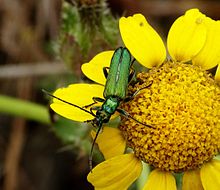Oedemeridae
| False Blister Beetles | |
|---|---|

| |
| Anogcodes seladonius on a yellow chamomile. | |
| Scientific classification | |
| Kingdom: | |
| Phylum: | |
| Class: | |
| Order: | |
| Suborder: | |
| Infraorder: | |
| Superfamily: | |
| Family: | Oedemeridae Latreille, 1810
|
| Subfamilies | |
The family Oedemeridae is a cosmopolitan group of beetles commonly known as false blister beetles, though some recent authors have coined the name pollen-feeding beetles. There are some 100 genera and 1,500 species in the family[1], mostly associated with rotting wood as larvae, though adults are quite common on flowers.
Characteristics
Oedemeridae may be defined as slender, soft-bodied beetles of medium size found mostly on flowers and foliage. The head lacks a narrow neck, the antennae are long and filiform, the pronotum lacks lateral edges and is much narrower than elytra, the tarsi are heteromerous with bilobed penultimate segment, the procoxal cavities are open behind and the procoxae are conical and contiguous.
Natural history
The larvae of most genera are xylophagous, boring tunnels in spongy, damp wood in an advanced state of decomposition; thus they have little economic importance, with the exception of one species, the "wharf borer" (Nacerdes melanura), that is ever known to attain pest status, as its larvae bore into wet wood in coastal areas; larvae can also bore into wood located in the tidal zone so at times are submerged by seawater, and can damage docks, wharves, and pilings. Larvae of the genera Oedemera and Stenostoma develop in dead stems of herbaceous plants.
Adults contain the toxic cantharidin in their corporal fluids as a defensive mechanism; several species show brilliant and metallic blue, green, gold or coppery, often combined with yellow, orange or red, aposematic colourations. In temperate regions, adults are mainly polyphagous pollen and nectar-feeding, and diurnal in activity. In tropical areas, most are nocturnal and are attracted to light.

References
- '^ Vázquez, X. A., 2002. European Fauna of Oedemeridae. Argania Editio, Barcelona, 178 pp. ISBN 84-931847-4-8
